Analysis of Stability and Required Offset with Vibration Velocity Considering Conditions of Bedrock and Explosive Charges Using the TBM and NATM Extension Blasting Method
Abstract
:1. Introduction
2. Literature Review
3. Numerical Analysis
3.1. Modeling
3.2. Blasting Load Calculation
3.3. Analysis Case and Measurement Location
4. Numerical Analysis Results
4.1. Effects of Blasting Vibration on the TBM Backup Unit Adjacent to the Blasting Point
4.2. Effects of Blasting Vibration on the TBM and Ground above the TBM
4.3. Effects of Blasting Vibration on the Tunnel Face and Ground Surface
5. Conclusions
- Depending on the type of rock and powder factor, the transmitted vibration velocity differs significantly. The measured vibration velocity increased with denser rock or higher powder factor. Based on the characteristics of blasting using a TBM and the NATM in parallel, which only blasts a contour hole without center-cut blasting, the effects of blasting vibration were greater on the sidewalls than on the bottom of the TBM backup device. In cases where the blasting point was separated from the sidewall by 7 m or more, or a distance of 3 m or more was secured to the bottom point, the vibration values were measured to be lower than the regulated values for large RC buildings. Therefore, it was determined that the TBM backup device should have a minimum separation distance of 7 m to ensure safety. Otherwise, an appropriate protection device is required.
- In our analysis of blasting vibration on the TBM, the results were lower than the permissible values for houses and apartments in the Seoul subway system, except for the case of hard rock with a powder factor of 2.0 kg. Regardless of the rock type, the effects of blasting vibration transmitted to the ground above the TBM were higher than the vibration regulation value applicable to shopping complexes, offices, and public buildings when the powder factor was 2.0 kg or more. The effect was lower than the vibration regulation value applicable to houses and apartments when the powder factor was 0.75 kg or less or when the length of the pilot tunnel was extended to 12 m. Consequently, in cases with aboveground sensitivities, the powder factor should be reduced for safer construction. An adjustment of the powder factor when the ground is solid will shorten the pilot tunnel and construction period, which is anticipated to be economically beneficial.
- In all cases, except for hard rock with a load of 2.0 kg or more, the blasting vibration transmitted to the tunnel face and ground surface had lower vibration values than the regulated values for houses and apartments. Therefore, it is expected that the damage to the ground surface and structures would not be excessive.
- This study was limited to a specific tunnel size. The size of the required tunnel varies according to the utilization of the underground space, and the effect of vibration is expected to vary according to the size of the TBM pilot tunnel. Therefore, in future studies, the interaction between various NATM and TBM pilot tunnel sizes should be studied. In addition, this study simulated only the minimal shell blasting caused by the pilot tunnel. Additional research will be conducted on the number of blast holes, spacing, and cross-sectional shape under various conditions.
Author Contributions
Funding
Institutional Review Board Statement
Informed Consent Statement
Data Availability Statement
Conflicts of Interest
References
- Chun, B.S.; Song, S.H.; An, J.W. Ground behaviuor and reinforcing method of NATM tunnel through deep weathered zone. J. Korean Geotech. Soc. 2007, 23, 87–95. [Google Scholar]
- Heo, J.; Kim, B.I.; Lee, J.D.; Kim, Y.G. 3D numerical study on the reinforcing effect of inclined system bolting in NATM tunnel. J. Korean Geotech. Soc. 2017, 33, 29–36. [Google Scholar]
- Jeon, Y.J.; Lee, C.J. A Study on the behavior of single piles to adjacent tunneling in stiff clay. J. Korean Geo-Environ. Soc. 2015, 16, 13–22. [Google Scholar] [CrossRef] [Green Version]
- Kim, K.Y.; Kim, J.J.; Ryu, H.W.; Rehman, H.; Jafri, T.; Yoo, H.K.; Ha, S.G. Estimation method for TBM cutterhead drive design based on full-scale tunneling tests for application in utility tunnels. Appl. Sci. 2020, 10, 5187. [Google Scholar] [CrossRef]
- Liu, C.; Peng, Z.; Pan, L.; Yang, Y.; Chen, W.; Jiang, H. Influence of tunnel boring machine (TBM) advance on adjacent tunnel during ultra-rapid underground pass (URUP) tunneling: A case study and numerical investigation. Appl. Sci. 2020, 10, 3746. [Google Scholar] [CrossRef]
- Kong, S.M.; Choi, S.I.; Shim, S.B.; Lee, H.N.; Oh, D.W.; Lee, S.W. Stability Evaluation of TBM Pilot Tunnels to Rear Blasting Using the Protection Shield. Appl. Sci. 2021, 11, 1759. [Google Scholar] [CrossRef]
- Jo, H.; Park, J.I.; Lee, K.H. A case study on the NATM tunnel excavation under the soft soil ground condition by back analysis method. J. Korean Tunn. Undergr. Space Assoc. 2000, 2, 71–81. [Google Scholar]
- Kim, Y.S.; Jeong, W.S.; Lee, S.Y.; Seok, T.R. The prediction for ground movement of urban NATM tunnels using the strain-softening model. J. Korean Tunn. Undergr. Space Assoc. 2006, 8, 21–30. [Google Scholar]
- Hajihassani, M.; Abdullah, S.S.; Asteris, P.G.; Armaghani, D.J. A gene expression programming model for predicting tunnel convergence. Appl. Sci. 2019, 9, 4650. [Google Scholar] [CrossRef] [Green Version]
- Vitali, O.P.M.; Celestino, T.B.; Bobet, A. Construction strategies for a NATM tunnel in São Paulo, Brazil, in residual soil. Undergr. Space KeAi 2021, 4, 1–18. [Google Scholar] [CrossRef]
- Sauer, G.; Lama, R.D. An application of New Austrian Tunneling Method in difficult built over areas in Frankfurt/Main Metro. Symp. Rock Mech. Tunn. Probl. 1973, 1, 79–92. [Google Scholar]
- Kim, H.J.; Moon, H.K.; Lee, Y.J. Insights into the New Austrian Tunnelling Method (NATM) Ⅱ. Geotech. Eng. Korean Geotech. Soc. 2010, 26, 45–51. [Google Scholar]
- MOLIT. Tunnel Standard Specification; Ministry of Land, Infrastructure, and Transport: Seoul, Korea, 1999; p. 1.
- MOLIT. Review of Blast Noise and Vibration Tolerance Standards; Ministry of Land, Infrastructure, and Transport: Seoul, Korea, 2002; pp. 9–29.
- Jung, H.S. Rock Mechanics for Civil Engineers; Saeron: Seoul, Korea, 2004; pp. 262–342. [Google Scholar]
- FEIS. Construction-Related Noise and Vibration Impacts. Access to the Region’s Core; FEIS: New York, NY, USA, 2008; pp. 5.7.1–5.7.10. [Google Scholar]
- Itasca Consulting Group Inc. FLAC3D6.0 Manual: Examples (An. Excerpt from FLAC3D Help); Itasca Consulting Group Inc.: St. Paul, MN, USA, 2017; pp. 39–52. [Google Scholar]
- Jeon, S.S.; Cho, B.S.; Kim, D.S.; Jang, Y.W. Evaluation of the Tunnel Stability Induced by Blast Loading. In Proceedings of the Korean Society of Civil Engineers 2006 Convention Conference and Civil Expo, Seoul, Korea, 25 May 2006; pp. 4306–4309. [Google Scholar]
- Oh, W.K. A Study on the Ground Reinforcement for Constructability of Tubular Roof Construction Method. Master’s Thesis, Hanyang University, Seoul, Korea, 2008; p. 45. [Google Scholar]
- Hino, K. Theory and Practice of Blasting; Nippon Kayaku Co., Ltd.: Tokyo, Japan, 1959. [Google Scholar]
- Starfield, A.M.; Pugliese, J.M. Compression waves generated in rock by cylindrical explosive charges: A comparison between a computer model and field measurements. Int. J. Rock Mech. Min. Sci. Geomech. Abstr. 1968, 5, 65–77. [Google Scholar] [CrossRef]
- Jeon, S.S.; Jang, Y.W.; Jung, D.H. Estimation of blasting distance satisfying allowable peak particle velocity—Analytical & Numerical analysis approach. J. KOSHAM 2007, 7, 39–46. [Google Scholar]
- Ahn, J.K.; Park, D.H.; Shin, Y.W.; Park, I.J. Generation of blast load time series under tunneling. J. Korean Tunn. Undergr. Space Assoc. 2014, 16, 51–61. [Google Scholar] [CrossRef]
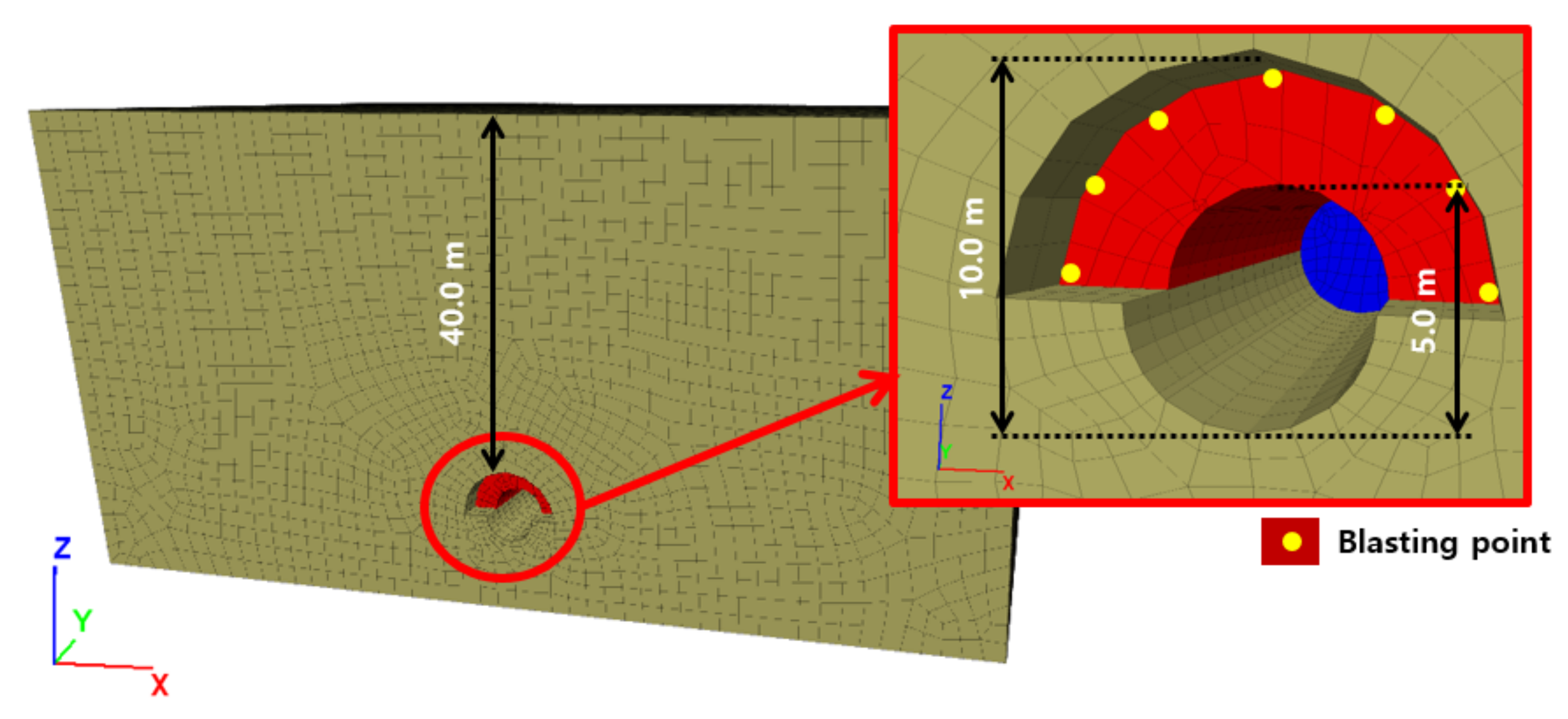
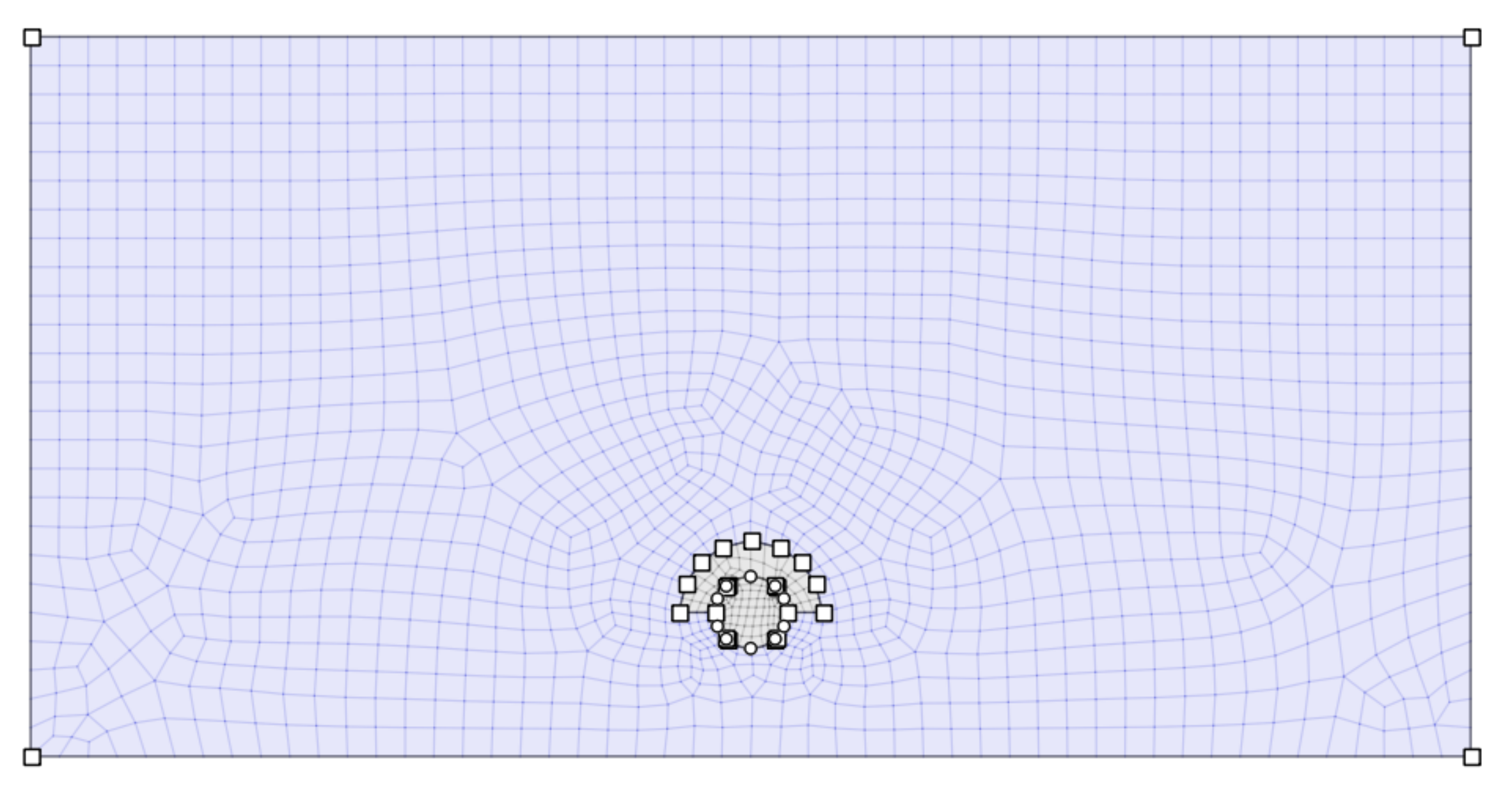
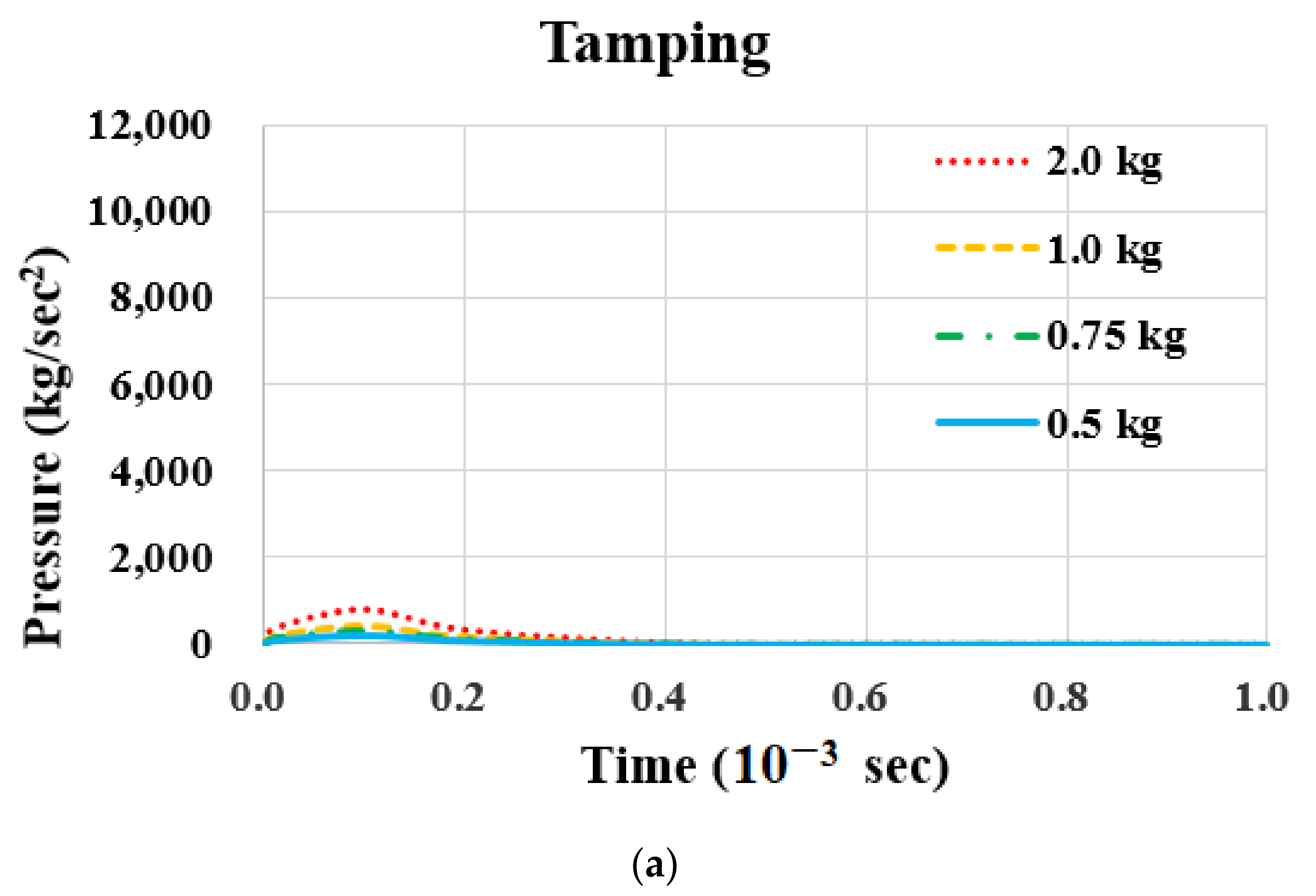
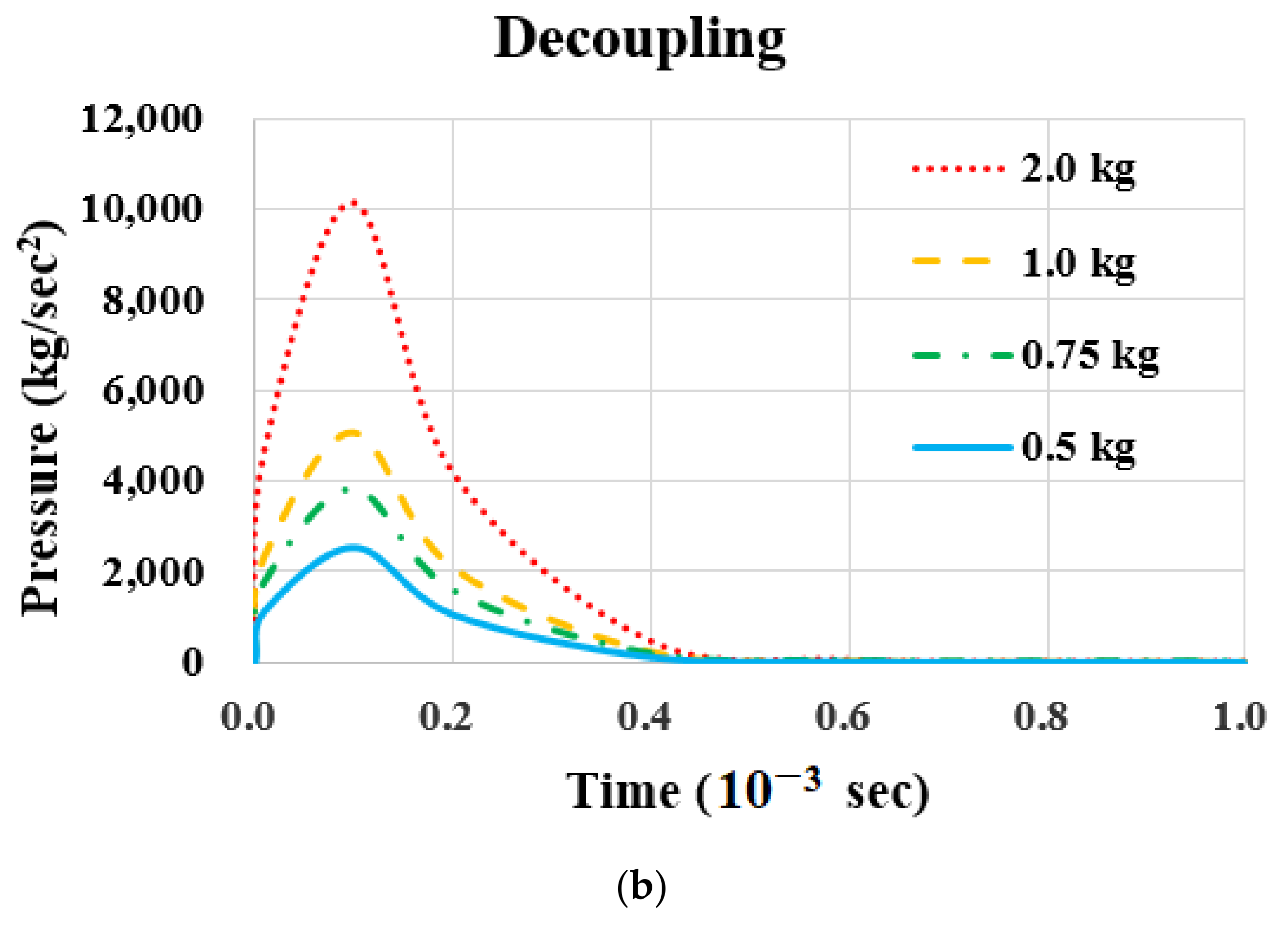
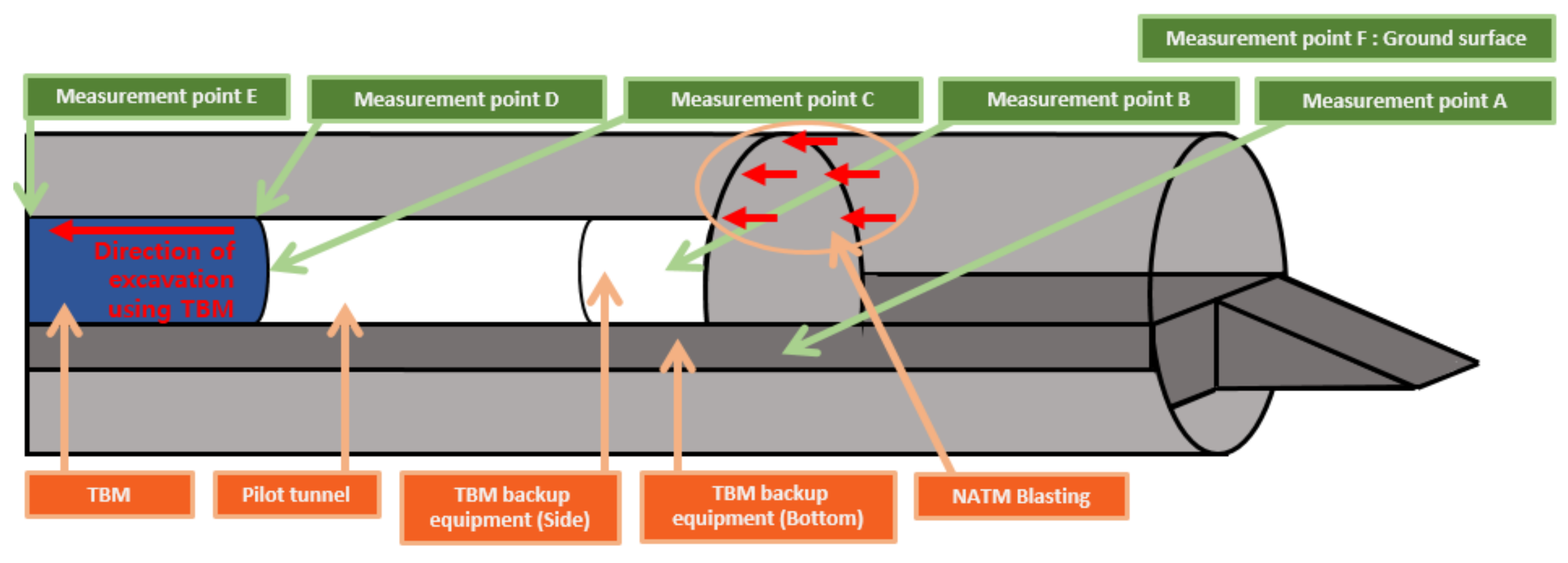
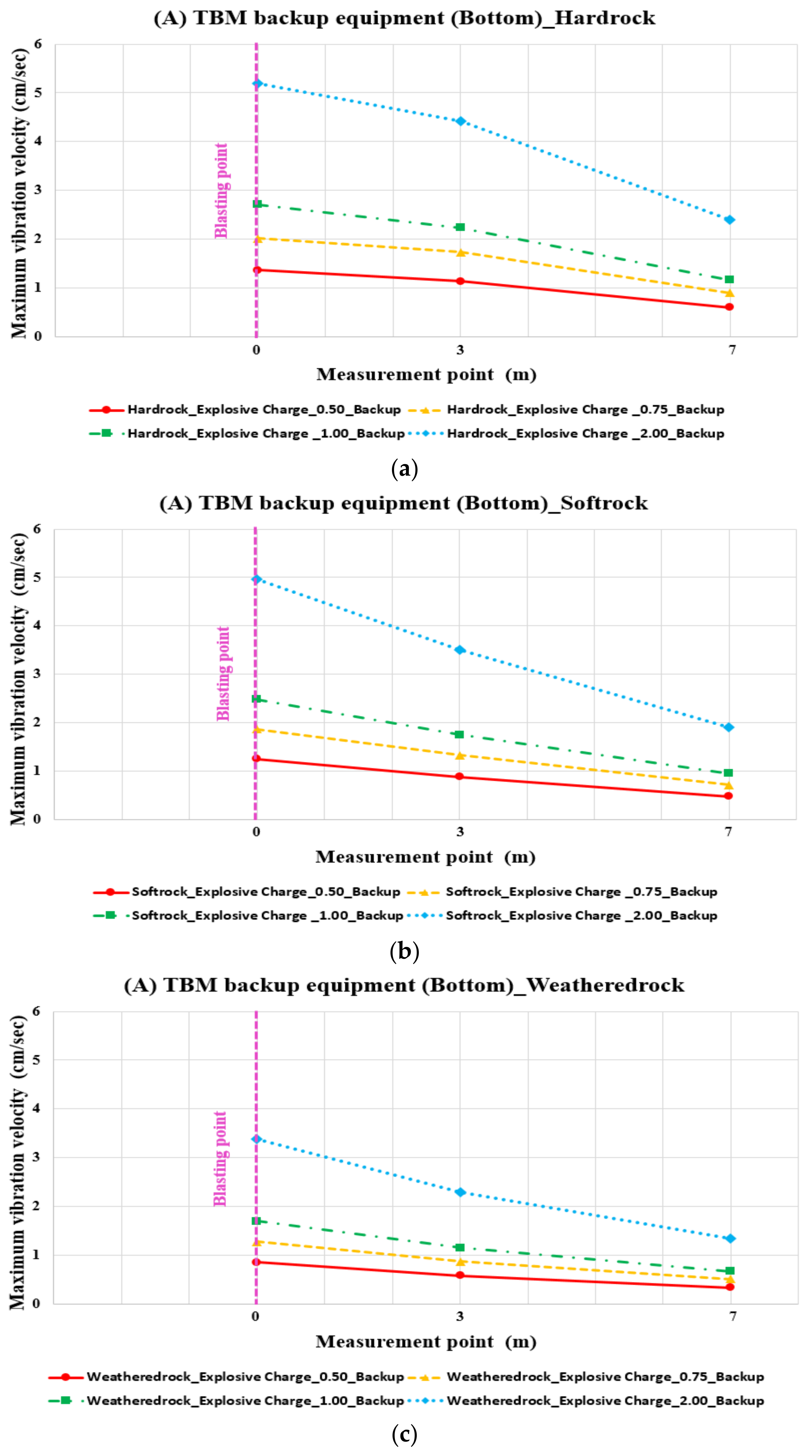
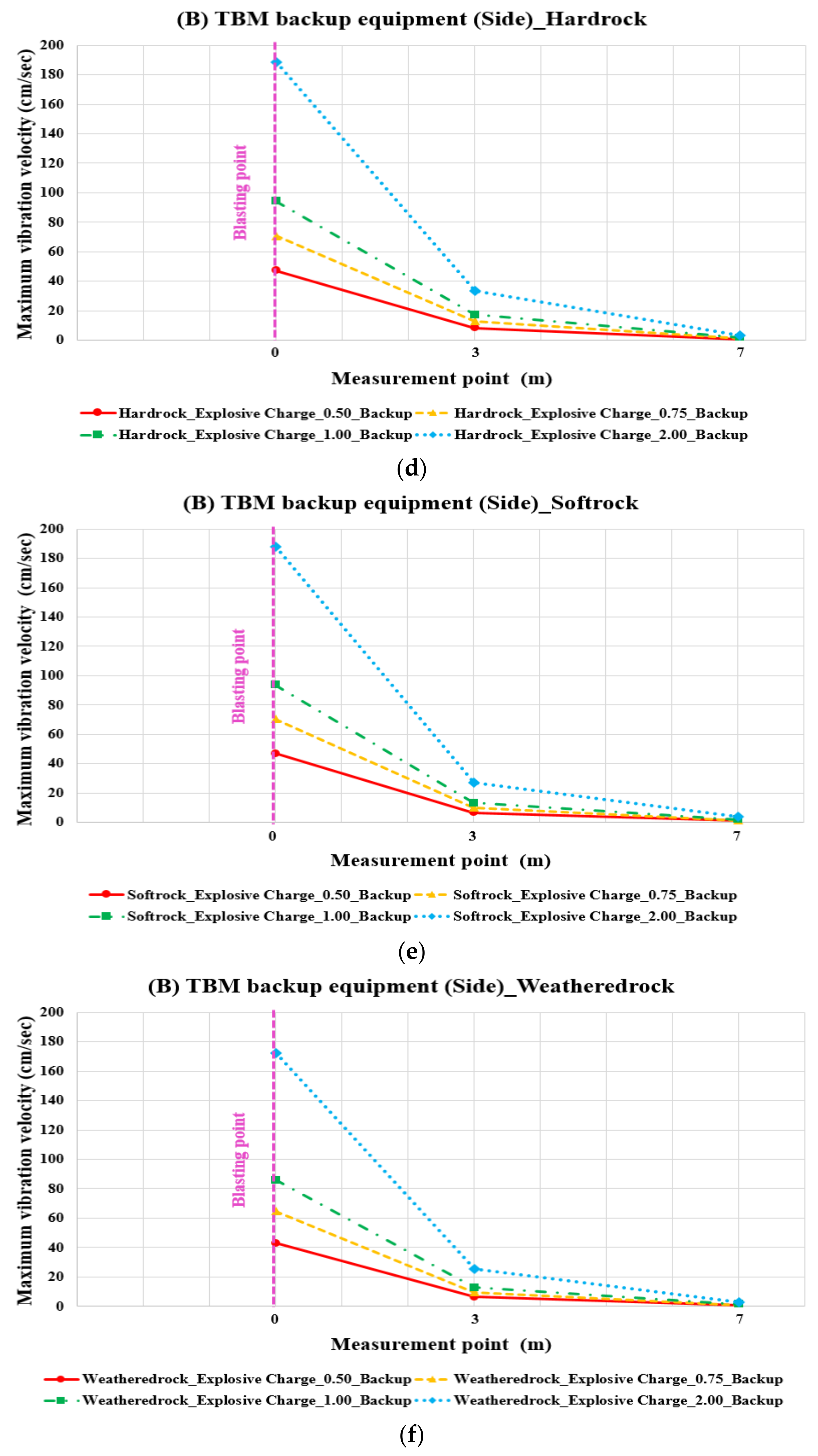
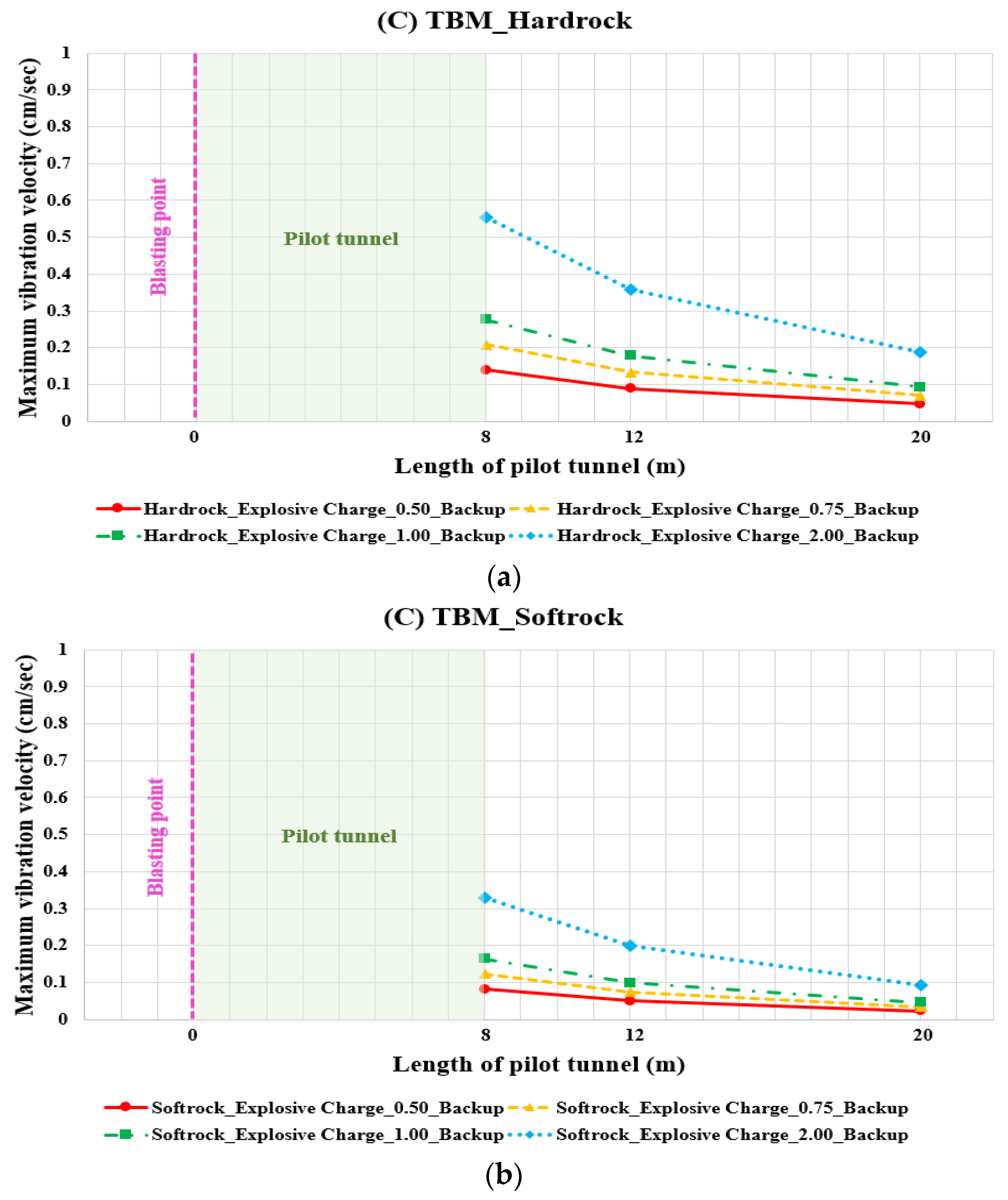
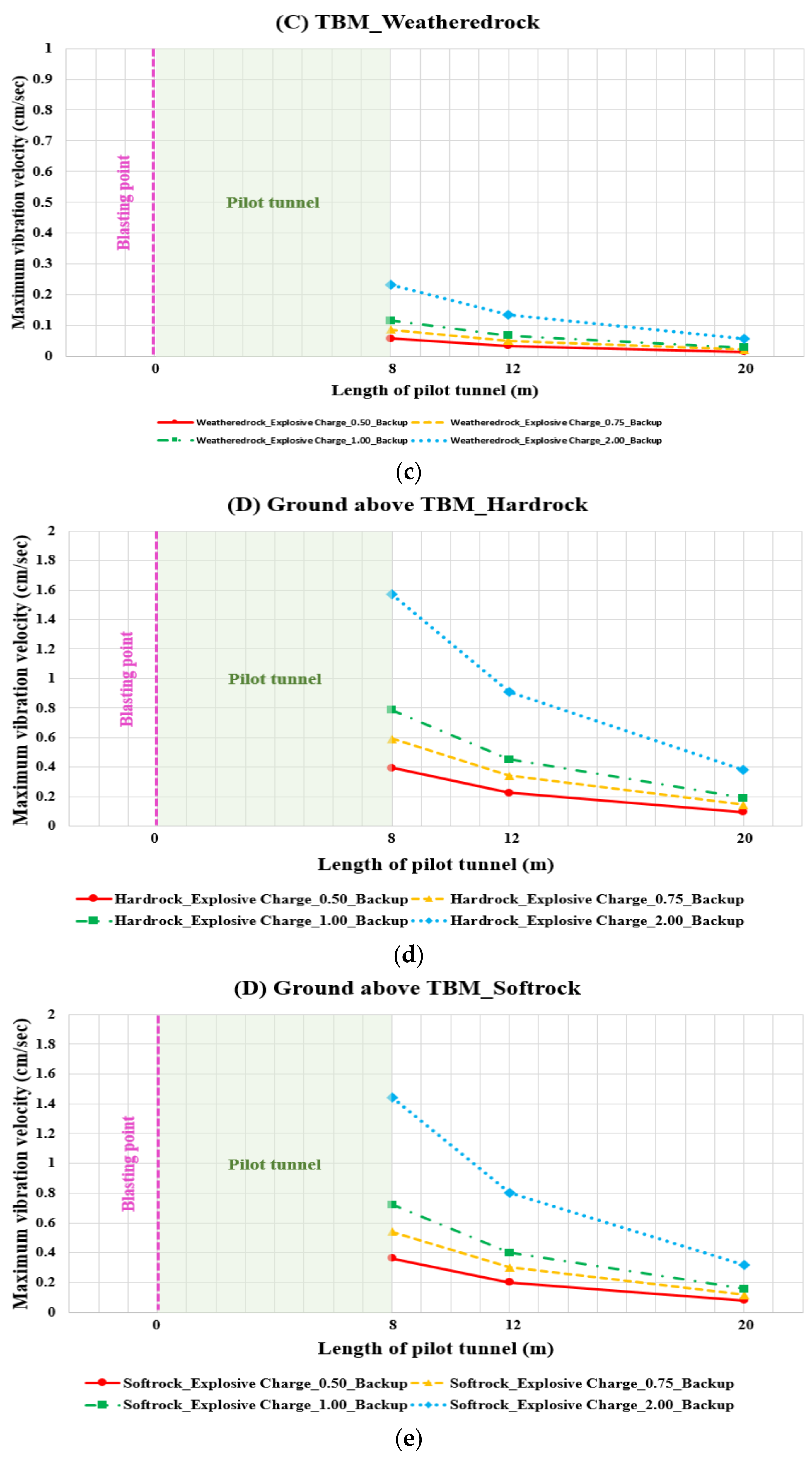
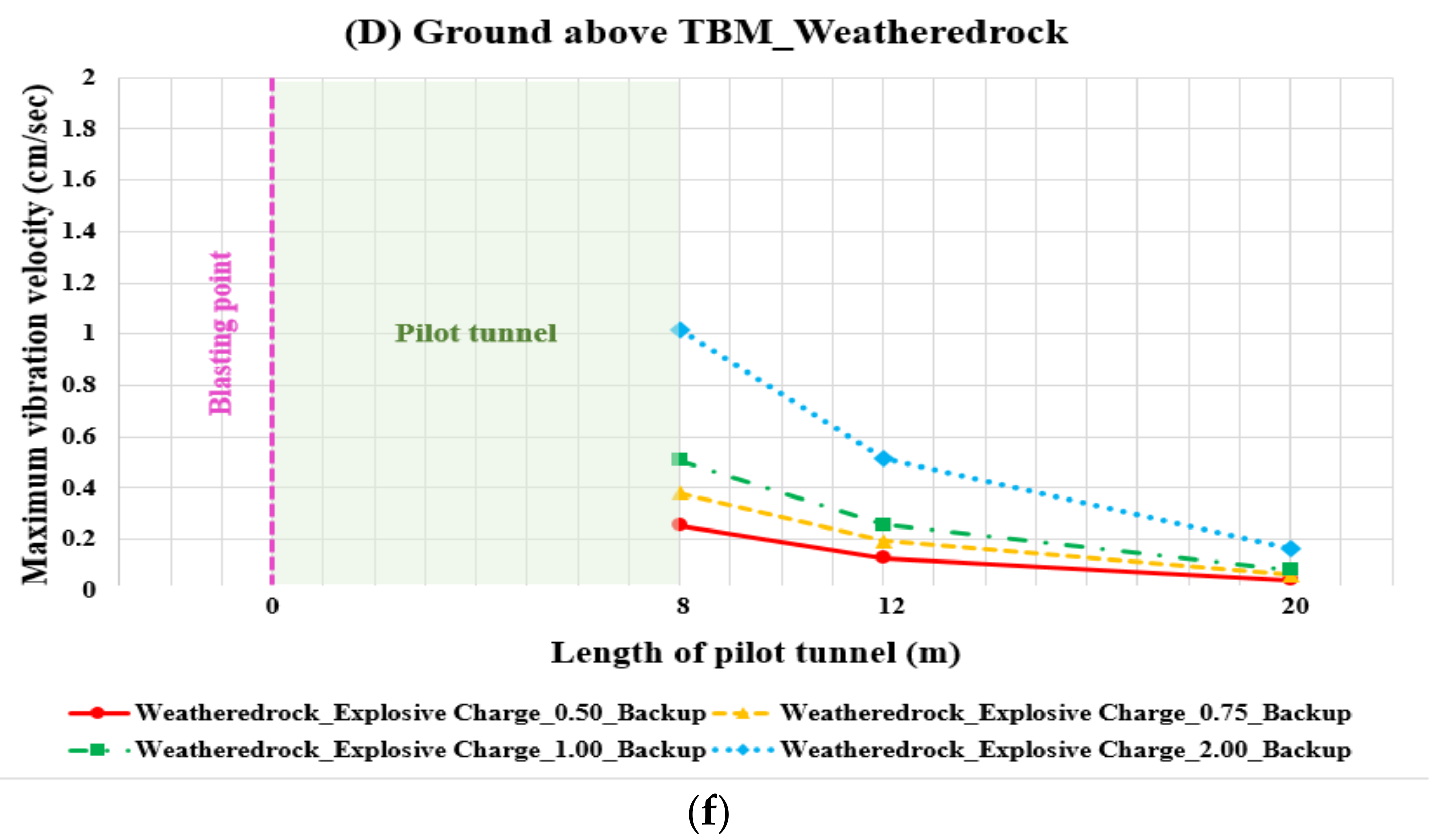
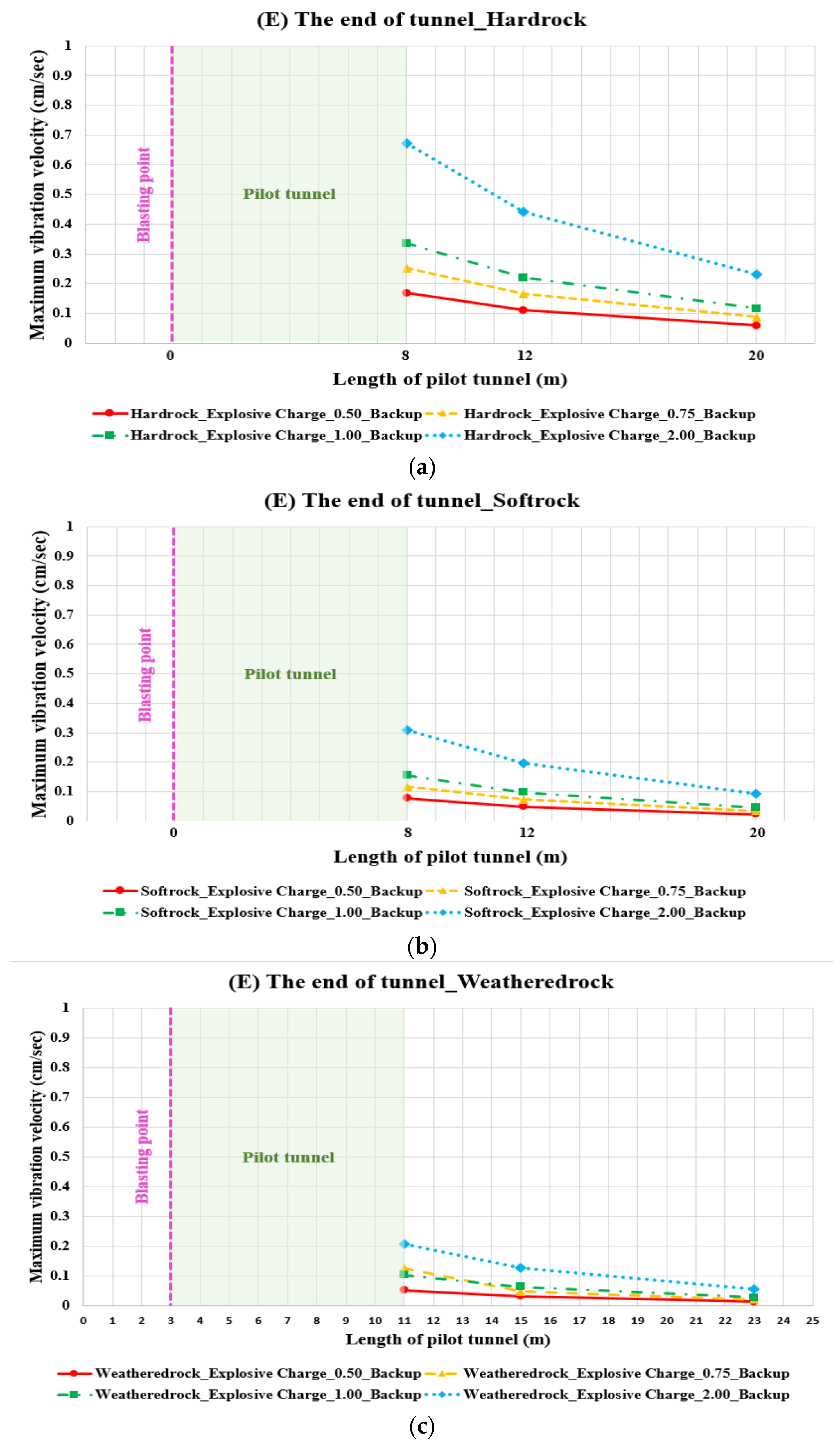

| Project Name | Period | TBM Size (m) | Construction Length (m) |
|---|---|---|---|
| Cable Tunnel in Pyeongtaek-si | June 2016–August 2017 | 2.9 | 134 |
| Jungnyeong Tunnel | April 1997–2001 | 5.0 | 4122 × 2 |
| New town bypass in Haeundae | December 1992–1995 | 4.5 | 2200 |
| Northern urban highway (Section 2) | December 1991–December 1996 | 6.5/7.0 | 1783 × 2 |
| Line 5 of Seoul Subway (Sections 5–21) | December 1990–December 1993 | 3.5 | 628 × 2 |
| Building Type | Permissible Vibration (cm s−1) |
|---|---|
| Vibration-sensitive structures (cultural heritage) | 0.3 |
| Structures with masonry infill walls and timber ceilings (traditional houses and low-rise general houses) | 1.0 |
| Masonry buildings with underground foundations and concrete slabs (row houses) | 2.0 |
| Medium and small buildings with reinforced concrete framework and slabs (low-rise apartments) | 3.0 |
| Large buildings with reinforced concrete, reinforced framework, and slabs (high-rise apartments) | 5.0 |
| Classification | Building Type | Permissible Vibration (cm s−1) |
|---|---|---|
| Seoul subway | Cultural heritage and buildings with precision machinery | 0.2 |
| Houses and apartments | 0.5 | |
| Shopping complexes, offices, and public buildings | 1.0 | |
| Reinforced concrete and steel frame factories | 4.0 | |
| Busan subway | Cultural heritage such as relics or ancient sites | 0.2 |
| Nearby computer facilities | 0.2 | |
| Houses and apartments | 0.5 | |
| Shopping complexes | 1.0 | |
| Reinforced concrete buildings and factories | 1.0–4.0 |
| Classification | Building Type | Permissible Vibration (cm s−1) |
|---|---|---|
| United Kingdom | Tunnel blasting in densely populated areas | 1.0 |
| Tunnel blasting in areas with low population density | 2.5 | |
| Open-pit blasting at a frequency of 12 Hz or less | 1.2 | |
| Other | 0.5 | |
| United States | Vibration with a frequency of 40 Hz or more | 5.0 |
| Vibration with a frequency of 15 Hz or more | 1.0 | |
| Vibration with a frequency of 1 Hz or less | 0.5 | |
| Japan | No damage caused | 0.2 |
| Vibration can be detected, but no structural damage occurs | 0.2–0.5 | |
| Microscopic damage occurs only in areas where the structure is particularly vulnerable | 0.5–1.0 | |
| Austria | Vibration with a frequency of 15 Hz or more | 1.9 |
| Vibration with a frequency below 15 Hz | 0.02 | |
| Switzerland | Historical relics or sensitive structures at 10 to 60 Hz | 0.762 |
| Historical relics or sensitive structures at 60 to 90 Hz | 1.27 |
| TBM Type | Soil | PPV | ||
|---|---|---|---|---|
| Small diameter | Bedrock | 0.03048 at 7.62 m | 0.0381 at 30.48 m | 0.0013462 at 60.96 m |
| Five-to-six meter diameter | Bedrock | 0.5588 at 4.88 m | 0.2286 at 10.06 m | 0.0762 at 20.12 m |
| 0.0508 at 24.99 m | 0.0381 at 30.48 m | 0.013208 at 60.96 m | ||
| Glacial till/ dense sand | 0.3048 at 4.88 m | 0.127 at 10.06 m | 0.0508 at 20.12 m | |
| 0.0254 at 24.99 m | 0.02032 at 30.48 m | 0.00762 at 60.96 m | ||
| Soft river silt/clay | 0.01016 at 10.06 m | 0.002032 at 20.17 m | 0.00254 at 24.99 m | |
| 0.002032 at 30.48 m | 0.000762 at 60.96 m | |||
| Title 1 | Model | γ (k N m−3) | E (k N m−2) | ν | c (k N m−2) | Φ‘ (°) |
|---|---|---|---|---|---|---|
| Weathered Rock | M-C | 20 | 70,000 | 0.3 | 25 | 36 |
| Soft rock | M-C | 23 | 250,000 | 0.2 | 140 | 32 |
| Hard rock | M-C | 27 | 12,900,000 | 0.2 | 1890 | 40 |
| TBM | Elastic | 78.5 | 20,000,000 | 0.2 | - | - |
| Variable①: Pilot Tunnel Length (m) | 4 | 8 | 16 | |||
| Variable②: Rock Condition | Weathered Rock | Soft rock | Hard rock | |||
| Variable③: Powder Factor (kg) | 0.5 | 0.75 | 1.0 | 2.0 | ||
| Measurement Point | Position |
|---|---|
| A | TBM backup equipment (bottom) |
| B | TBM backup equipment (side) |
| C | Rear of TBM |
| D | Ground above the TBM |
| E | TBM tunnel face |
| F | Ground surface |
Publisher’s Note: MDPI stays neutral with regard to jurisdictional claims in published maps and institutional affiliations. |
© 2022 by the authors. Licensee MDPI, Basel, Switzerland. This article is an open access article distributed under the terms and conditions of the Creative Commons Attribution (CC BY) license (https://creativecommons.org/licenses/by/4.0/).
Share and Cite
Kong, S.-M.; Kim, A.-R.; Byun, Y.; Shim, S.; Choi, S.-I.; Lee, S.-W. Analysis of Stability and Required Offset with Vibration Velocity Considering Conditions of Bedrock and Explosive Charges Using the TBM and NATM Extension Blasting Method. Appl. Sci. 2022, 12, 3473. https://doi.org/10.3390/app12073473
Kong S-M, Kim A-R, Byun Y, Shim S, Choi S-I, Lee S-W. Analysis of Stability and Required Offset with Vibration Velocity Considering Conditions of Bedrock and Explosive Charges Using the TBM and NATM Extension Blasting Method. Applied Sciences. 2022; 12(7):3473. https://doi.org/10.3390/app12073473
Chicago/Turabian StyleKong, Suk-Min, Ah-Ram Kim, Yoseph Byun, Seungbo Shim, Sang-Il Choi, and Seong-Won Lee. 2022. "Analysis of Stability and Required Offset with Vibration Velocity Considering Conditions of Bedrock and Explosive Charges Using the TBM and NATM Extension Blasting Method" Applied Sciences 12, no. 7: 3473. https://doi.org/10.3390/app12073473






